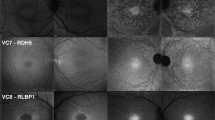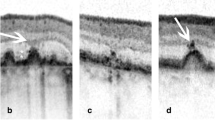Abstract
Purpose
To characterize autofluorescence (AF) patterns occurring in Stargardt macular dystrophy (STGD1) using ultra-wide-field (UWF) imaging.
Methods
This paper is a cross-sectional observational study of 22 eyes of 11 patients (mean age 23.44 years) with Stargardt disease-fundus flavimaculatus who presented with decrease of vision at a tertiary eye care center. UWF short-wave AF images were obtained from all the patients using an Optos TX200 instrument. The main outcome measures were to assess patterns of AF changes seen on UWF AF imaging.
Results
All eyes showed a central area of hypoautofluorescence at the macula along with retinal flecks extending centrifugally as well as to the nasal side of the optic disc. Peripapillary sparing was seen in 100% of the eyes. Flecks were seen to be hypoautofluorescent in the center and hyperautofluorescent in the periphery in 77.8% eyes and were only hyperfluorescent in 27.2%. A background-increased fluorescence was visible in 100% of eyes, the outer boundary of which was marked by distribution of flecks in 81.9% eyes. A characteristic inferonasal vertical line was seen separating the nasal hypoautofluorescent area from the temporal hyperautofluorescent area in all the eyes.
Conclusions
UWF AF changes in STGD1 are not limited to the posterior pole and may extend more peripherally. UWF imaging is a useful tool for the assessment of patients with Stargardt macular dystrophy.







Similar content being viewed by others
References
Roosing S, Thiadens AA, Hoyng CB, Klaver CC, den Hollander AI, Cremers FP (2014) Causes and consequences of inherited cone disorders. Prog Retin Eye Res 42:1–26
Allikmets R, Singh N, Sun H et al (1997) A photoreceptor cell specific ATP-binding transporter gene (ABCR) is mutated in recessive Stargardt macular dystrophy. Nat Genet 15:236–246
Mata NL, Weng J, Travis GH (2000) Biosynthesis of a major lipofuscin fluorophore in mice and humans with ABCR-mediated retinal and macular degeneration. Proc Natl Acad Sci U S A 97:7154–7159
Ablonczy Z, Higbee D, Anderson DM, Dahrouj M, Grey AC, Gutierrez D et al (2013) Lack of correlation between the spatial distribution of A2E and lipofuscin fluorescence in the human retinal pigment epithelium. Invest Ophthalmol Vis Sci 54:5535–5542
Smith RT, Gomes NL, Barile G, Busuioc M, Lee N, Laine A (2009) Lipofuscin and autofluorescence metrics in progressive STGD. Invest ophthalmol Vis Sci 50:3907–3914
Hwang JC, Chan JW, Chang S, Smith RT (2006) Predictive value of fundus autofluorescence for development of geographic atrophy in age-related macular degeneration. Invest Ophthalmol Vis Sci 47:2655–2661
Burke TR, Duncker T, Woods RL, Greenberg JP, Zernant J, Tsang SH, Smith RT, Allikmets R, Sparrow JR, Delori FC (2014) Quantitative fundus autofluorescence in recessive Stargardt disease. Invest Ophthalmol Vis Sci 55:2841–2852
Fujinami K, Lois N, Mukherjee R et al (2013) A longitudinal study of Stargardt disease: quantitative assessment of fundus autofluorescence, progression, and genotype correlations. Invest Ophthalmol Vis Sci 54:8181–8190
Choudhry N, Giani A, Miller JW (2010) Fundus autofluorescence in geographic atrophy: a review. Semin Ophthalmol 25:206–213
von Ruckmann A, Fitzke FW, Bird AC (1995) Distribution of fundus autofluorescence with a scanning laser ophthalmoscope. Br J Ophthalmol 79:407–412
Gomes NL, Greenstein VC, Carlson JN et al (2009) A comparison of fundus autofluorescence and retinal structure in patients with Stargardt disease. Invest Ophthalmol Vis Sci 50:3953–3959
Cukras CA, Wong WT, Caruso R, Cunningham D, Zein W, Sieving PA (2012) Centrifugal expansion of fundus autofluorescence patterns in Stargardt disease over time. Arch Ophthalmol 130:171–179
Duncker T, Marsiglia M, Lee W et al (2014) Correlations amongst near-infrared and short-wavelength autofluorescence and spectral domain optical coherence tomography in recessive Stargardt disease. Invest Ophthalmol Vis Sci 55:8134–8143
Patel M, Kiss S (2014) Ultra-wide-field fluorescein angiography in retinal disease. Curr Opin Ophthalmol 25:213–220
Eagle RC Jr, Lucier AC, Bernardino VB Jr, Yanoff M (1980) Retinal pigment epithelial abnormalities in fundus flavimaculatus: a light and electron microscopic study. Ophthalmology 87:1189–1200
Delori FC, Staurenghi G, Arend O, Dorey CK, Goger DG, Weiter JJ (1995) In vivo measurement of lipofuscin in Stargardt’s disease-fundus flavimaculatus. Invest Ophthalmol Vis Sci 36:2327–2331
von Ruckmann A, Fitzke FW, Bird AC (1997) In vivo fundus autofluorescence in macular dystrophies. Arch Ophthalmol 115:609–615
Duncker T, Lee W, Tsang SH, Greenberg JP, Zernant J, Allikmets R, Sparrow JR (2013) Distinct characteristics of Inferonasal fundus autofluorescence patterns in Stargardt disease and retinitis Pigmentosa. Invest Ophthalmol Vis Sci 54:6820–6826
Duncker T, Greenberg JP, Sparrow JR, Smith RT, Quigley HA, Delori FC (2012) Visualization of the optic fissure in short-wavelength autofluorescence images of the fundus. Invest Ophthalmol Vis Sci 53:6682–6686
Sparrow JR, Marsiglia M, Allikmets R, Tsang S, Lee W, Duncker T, Zernant J (2015) Flecks in recessive Stargardt disease: short-wavelength autofluorescence, near-infrared autofluorescence, and optical coherence tomography imaging of flecks. Invest Ophthalmol Vis Sci 56:5029–5039
Burke TR, Rhee DW, Smith RT, Tsang SH, Allikmets R, Chang S, Lazow MA, Hood DC, Greenstein VC (2011) Quantification of peripapillary sparing and macular involvement in Stargardt disease (STGD1). Invest Ophthalmol Vis Sci 52:8006–8015
Klufas MA, Tsui I, Sadda SR, Hosseini H, Schwartz SD (2017) Ultrawidefield autofluoresence in ABCA4 Stargardt disease. Retina. doi:10.1097/IAE.0000000000001567
Author information
Authors and Affiliations
Corresponding author
Ethics declarations
Funding
No funding was received for this research.
Conflict of interest
All authors certify that they have no affiliations with or involvement in any organization or entity with any financial interest (such as honoraria; educational grants; participation in speakers’ bureaus; membership, employment, consultancies, stock ownership, or other equity interest; and expert testimony or patent-licensing arrangements), or non-financial interest (such as personal or professional relationships, affiliations, knowledge or beliefs) in the subject matter or materials discussed in this manuscript.
Ethical approval
All procedures performed in this study were in accordance with the ethical standards of the institution and with the 1964 Helsinki Declaration and its later amendments or comparable ethical standards.
Informed consent
For this type of study, formal consent is not required.
Financial support
None.
Disclosure
None.
Additional information
This manuscript has not been submitted elsewhere for publication
Rights and permissions
About this article
Cite this article
Kumar, V. Insights into autofluorescence patterns in Stargardt macular dystrophy using ultra-wide-field imaging. Graefes Arch Clin Exp Ophthalmol 255, 1917–1922 (2017). https://doi.org/10.1007/s00417-017-3736-4
Received:
Revised:
Accepted:
Published:
Issue Date:
DOI: https://doi.org/10.1007/s00417-017-3736-4




